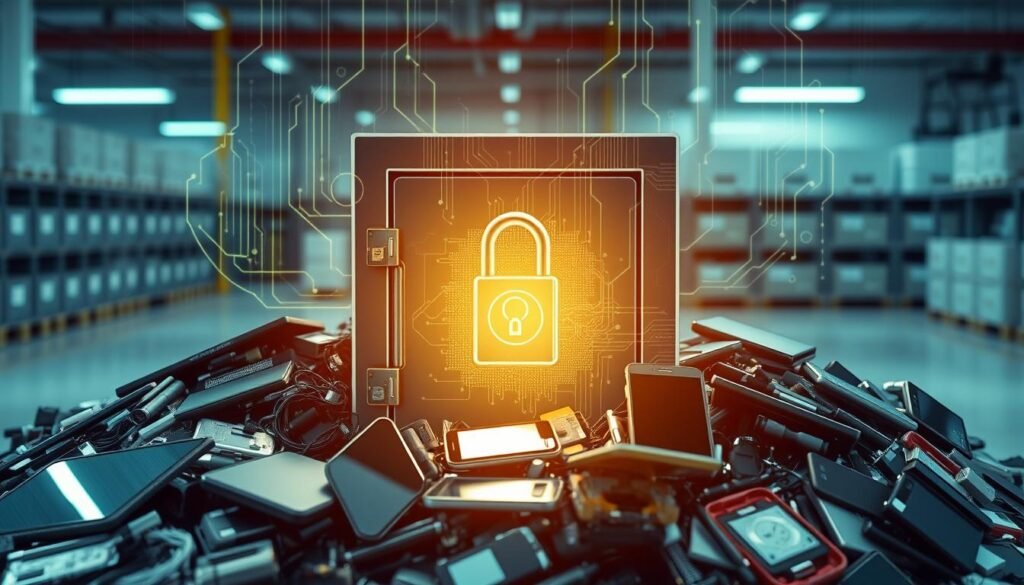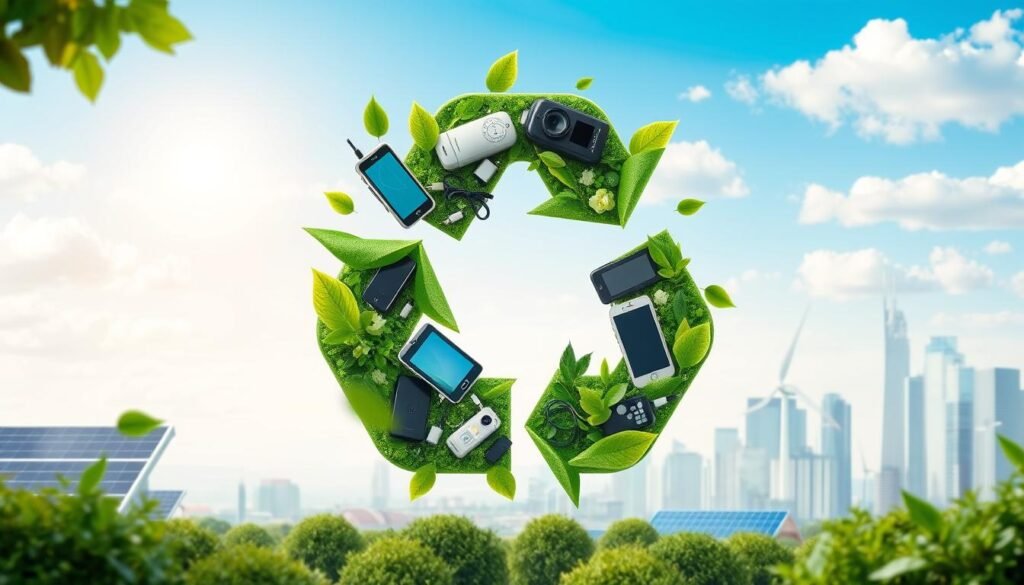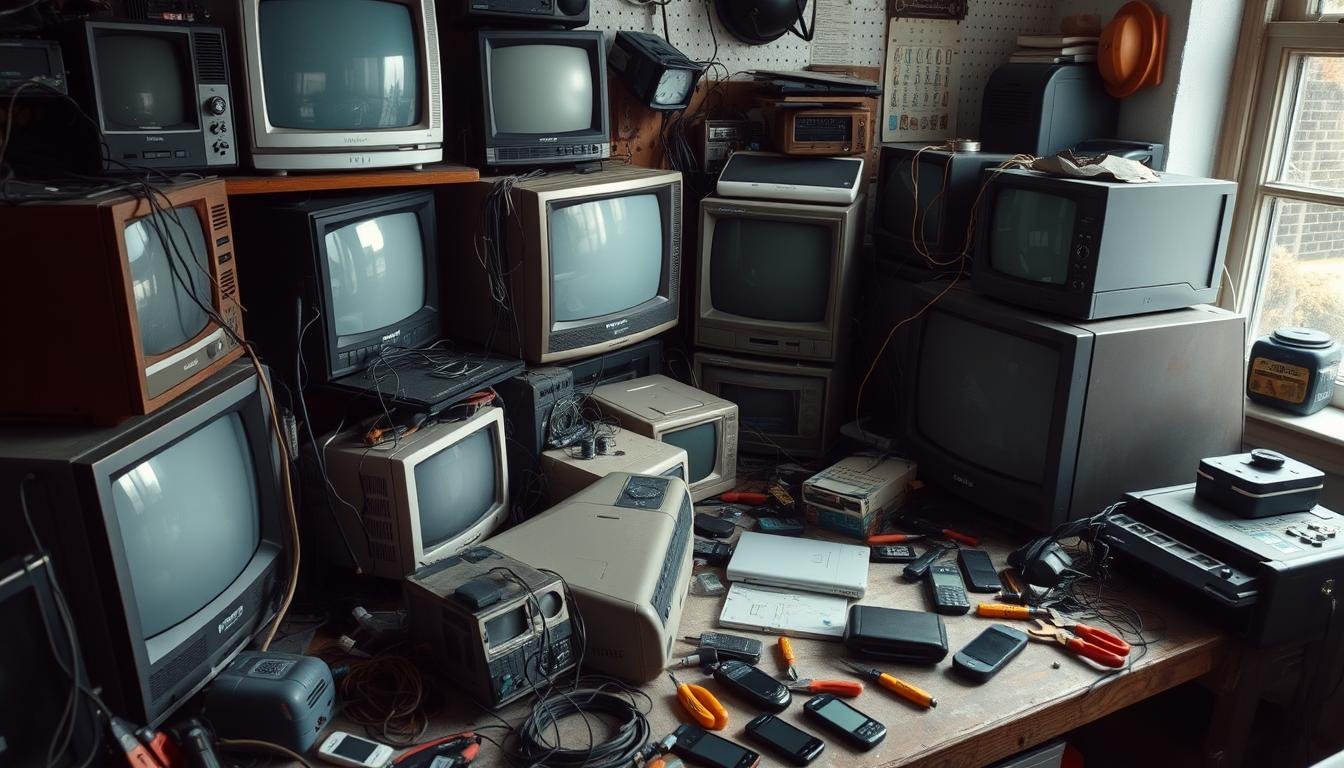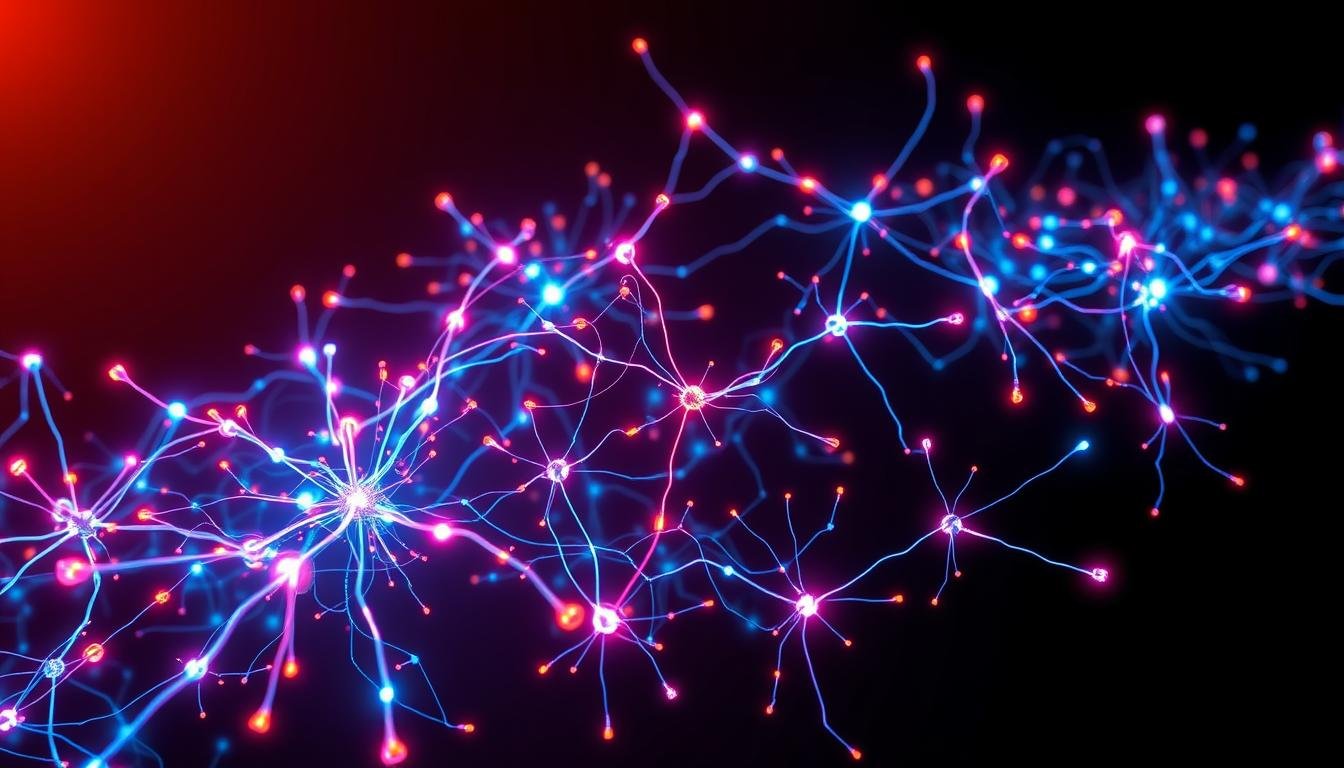Technology is changing fast, making e-waste management key. Properly getting rid of old electronics helps the planet and saves resources. This guide offers tips and best practices for safe disposal of outdated devices, reducing e-waste harm.
Key Takeaways
- Understand the environmental concerns of improper e-waste disposal and the importance of responsible management.
- Learn how to identify electronic devices that need to be disposed of or recycled.
- Discover best practices for preparing electronics for disposal or recycling, including data destruction and hazardous component removal.
- Explore various e-waste recycling options, including local electronics recycling centers and mail-back programs.
- Adopt eco-friendly alternatives to electronic devices to reduce your environmental footprint.
Understanding E-Waste and Its Environmental Impact
Electronic waste, or e-waste, is any old electrical or electronic device. This includes things like computers, smartphones, TVs, and appliances. As we use more technology, the amount of e-waste grows, creating a big environmental problem.
What is E-Waste?
E-waste is any electrical or electronic device that’s no longer useful. It includes all parts and materials of the device when it’s thrown away. Because it contains valuable and harmful materials, it’s important to dispose of it correctly.
Environmental Concerns of Improper E-Waste Disposal
Throwing away e-waste the wrong way can harm the environment a lot. Devices often have harmful substances like lead, mercury, and cadmium. If not disposed of right, these can pollute soil and water, harming both nature and people, especially kids and pregnant women.
| Hazardous Material | Potential Health and Environmental Impacts |
|---|---|
| Lead | Developmental issues, neurological damage, and kidney problems |
| Mercury | Neurological and developmental disorders, and damage to the brain, kidneys, and lungs |
| Cadmium | Kidney damage, bone disease, and cancer |
| Flame Retardants | Hormone disruption, reproductive issues, and neurological effects |
The environmental impact of e-waste gets worse because many devices end up in landfills or are dumped illegally. This lets harmful materials get into the environment. But, recycling e-waste can save valuable materials and reduce pollution.
“The improper disposal of e-waste can have devastating effects on ecosystems and human health, particularly for children and pregnant women living near informal e-waste recycling sites.”
Identifying Electronic Devices for Disposal
Technology changes fast, so it’s important to know when to get rid of old electronics. Figuring out when to replace your gadgets can be hard. But with some tips, you can make sure your e-waste is handled right.
Let’s look at some common electronics and when it’s time to say goodbye:
- Computers and Laptops: If your computer or laptop is over 5 years old, slow, or can’t update software, it’s time for a new one.
- Smartphones and Tablets: These devices usually last 2-3 years. If yours is slow, has a bad battery, or can’t get security updates, it’s time for a new one.
- Televisions: TVs usually last 7-10 years. But if new tech makes your TV outdated or inefficient, it might be time for a new one.
- Household Appliances: Big appliances like fridges and washers last 10-15 years. If yours is not working well or is unsafe, it’s time for a new one.
| Device | Average Lifespan | Factors to Consider for Disposal |
|---|---|---|
| Computers and Laptops | 5 years | Slow performance, inability to support software updates |
| Smartphones and Tablets | 2-3 years | Sluggish performance, failing battery, lack of security updates |
| Televisions | 7-10 years | Outdated technology, incompatibility with streaming services, energy inefficiency |
| Household Appliances | 10-15 years | Decreased efficiency, safety concerns |
Knowing how long different devices last and when to replace them helps. This way, you can recycle or dispose of old gadgets the right way.
“Proper disposal of electronic waste is not only good for the environment, but it also helps protect our communities from the potential hazards associated with improper e-waste management.”
How to Safely Dispose of Old Electronics: Best Practices for E-Waste Management
Getting rid of old electronics can seem tough, but it’s key to do it right for our planet. By using safe disposal of electronics and e-waste management tips, we can recycle or dispose of old gadgets in a environmentally-friendly way.
First, make sure to wipe all data from your devices. Use special software or physically destroy storage media to do this. After erasing data, remove any batteries or hazardous parts before you dispose of them.
- Wipe all data from your devices using secure data destruction methods.
- Safely remove batteries and other hazardous components from the electronics.
- Explore local e-waste recycling centers or mail-back programs to responsibly dispose of your old electronics.
- Consider donating or selling working devices to charitable organizations or online marketplaces.
By following these steps, you help ensure your old electronics are recycled or disposed of in a green way. This reduces harm to our environment. Remember, good e-waste management best practices are vital for our planet and resources.
| Disposal Method | Benefits | Drawbacks |
|---|---|---|
| Local E-Waste Recycling Center | Ensures proper recycling and disposal of materials | May require transportation to the center |
| Mail-Back Programs | Convenient, no need to transport devices | May have associated fees |
| Donating to Charitable Organizations | Extends the life of working devices | May have restrictions on device types |
| Selling Online | Generates income from used devices | Requires effort to list and sell items |
By thinking about your options and following these tips, you can make sure your old electronics are recycled or disposed of right. This helps reduce environmental harm and supports a greener future.
Preparing Electronics for Disposal or Recycling
When it’s time to say goodbye to your old electronics, it’s important to do it right. You need to make sure your data security and the environment are protected. Let’s look at what you should do.
Data Destruction and Wiping Techniques
Before you get rid of your electronics, you must wipe out any sensitive data security for electronics disposal. This includes personal info, financial records, and other private data. Use trusted tools and methods to erase all data, keeping your privacy safe.
Removing Batteries and Hazardous Components
Many devices have hazardous components in electronics that need special care when thrown away. Batteries, for example, should be taken out and recycled to avoid harming the environment. Some devices also have materials like mercury and lead that must be disposed of correctly to protect our planet.
| Component | Disposal Considerations |
|---|---|
| Batteries | Battery removal and recycling to prevent hazardous waste |
| Mercury, Lead, and Other Hazardous Materials | Proper disposal through specialized e-waste recycling programs |
By carefully preparing your electronics for disposal or recycling, you protect your data security for electronics disposal. You also ensure that any harmful parts are dealt with safely. This helps reduce the harm to our environment.

Exploring E-Waste Recycling Options
It’s important to manage your old electronics well for the planet. Luckily, there are many e-waste recycling programs and services to help. Let’s look at the options you have.
Local Electronics Recycling Centers
Recycling your e-waste locally is a great start. These centers take many devices like computers, TVs, and phones. To find one near you, search online for “e-waste recycling programs” or “local electronics recycling.”
Mail-Back Programs and Drop-Off Locations
If local centers are not an option, many brands offer mail-back programs. These let you send your old electronics to be recycled. Look for mail-back services from your device’s manufacturer or retailer.
Using these recycling options means your old electronics are handled right. This helps the environment and supports a greener future. It’s a small action we can all take.
Responsible E-Waste Management at Home
We all have a big role in managing e-waste at home. By adopting eco-friendly habits, we can help reduce electronic waste’s impact on the environment. Simple strategies in our daily lives can make a big difference.
First, let’s not buy new electronics too quickly. Check if your current device still works well. If it does, don’t rush to get a new one. This helps cut down on electronic waste and supports sustainable living.
When it’s time to get rid of an old device, don’t throw it away. Look for eco-friendly electronics disposal at home options. Many places offer e-waste collection programs. Find out what’s available in your area and use these services to recycle or dispose of your devices responsibly.
Keep your electronics safe and clean until you can dispose of them. Don’t let them get dusty or damaged. This makes them easier to recycle in the future. Set aside a special place in your home for e-waste, out of reach of kids and pets.
By following these household e-waste management tips, we can all help reduce electronic waste. Together, we can make the world a greener place by taking care of our electronic devices.
“The choices we make today will shape the world of tomorrow. Let’s commit to responsible e-waste management and create a cleaner, greener future for all.”
Donating or Selling Used Electronics
Instead of throwing away old electronics, you can give them a new life. Donating or selling them helps them last longer and supports a greener future.
Charitable Organizations and Donation Centers
Many charities take in used electronics to help others or recycle them. Places like Goodwill, Salvation Army, and Habitat for Humanity are great for donating laptops, phones, and more. Your donations can change lives for those who can’t afford new tech.
Online Marketplaces for Selling Used Electronics
If your gadgets still work, selling them online is a good idea. Sites like eBay, Facebook Marketplace, and Craigslist help you find buyers and get a good price. This way, you clean up your space and help the planet by keeping devices in use.
Donating or selling your old tech can help the environment and maybe even earn you some money. Always erase your data before giving away your devices to keep your info safe.
Understanding E-Waste Regulations and Laws
Understanding e-waste disposal is key in today’s world. In the United States, a mix of e-waste regulations and laws aim to manage these materials safely. This is important because e-waste can harm the environment.
The Resource Conservation and Recovery Act (RCRA) is the main law for e-waste at the federal level. It makes sure electronic devices are disposed of correctly. The Environmental Protection Agency (EPA) also helps by setting guidelines for e-waste management.
States and local areas have their own rules for e-waste too. These rules make sure companies and people dispose of electronics the right way. They also make sure electronics are recycled or disposed of safely.
Knowing the laws about e-waste in your area helps keep our environment safe. It also keeps our communities healthy. It’s everyone’s duty to dispose of e-waste properly.

“Proper e-waste disposal is not just a personal responsibility, but a civic duty that we all share in preserving the health of our planet.”
Promoting E-Waste Awareness and Education
It’s important to teach people about recycling old electronics. This helps make our future more sustainable. We can do this by working with our communities and starting educational programs. This way, we can help people learn how to manage e-waste properly.
Community Outreach and Campaigns
Community outreach and campaigns are great for teaching about e-waste. We can work with local groups, schools, and government to host events. These events help people learn how to recycle their old electronics right.
- Organize e-waste collection drives in your neighborhood or community center.
- Collaborate with schools to educate students about the importance of e-waste recycling.
- Distribute educational flyers and brochures to raise awareness in your local area.
- Utilize social media platforms to share tips and guidelines for responsible e-waste management.
“By working together as a community, we can make a significant impact in reducing the environmental burden of improper e-waste disposal.”
These efforts help people understand the importance of recycling old electronics. It encourages them to use eco-friendly ways to get rid of their old devices.
Eco-Friendly Alternatives to Electronic Devices
In our digital world, finding sustainable options is key. We aim to lessen our environmental footprint. I’m excited to share new ways to cut down on electronic waste and support green tech.
Sustainable electronics are becoming more common. They’re made to last longer, be fixed easily, and recycled. Companies like Fairphone and Shift focus on using ethical materials and fair production. This lets us choose products that are better for the planet.
Refurbished and secondhand devices are also gaining popularity. Buying used electronics helps them last longer and keeps them out of landfills. Sites like Back Market and Gazelle offer quality, affordable, and eco-friendly options instead of new ones.






